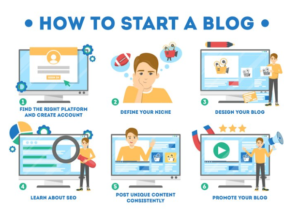Here’s a step-by-step guide to help you get started:

1. Define Your Purpose and Niche:
– Identify the main topic or theme of your blog.
– Define your target audience.
– Clarify your goals for starting the blog.
2. Choose a Blogging Platform:
– Popular platforms include WordPress, Blogger, Medium, and Wix.
– WordPress is highly customizable and widely used.
3. Select a Domain Name and Hosting:
– Choose a unique and memorable domain name that reflects your blog’s content.
– Purchase a domain name and select a reliable hosting provider if you’re using a self-hosted platform like WordPress.org.
4. Set Up Your Blog:
– Follow the instructions provided by your chosen platform to set up your blog.
– Customize the design, layout, and settings according to your preferences.
5. Create Quality Content:
– Plan your content strategy and create a content calendar.
– Write informative, engaging, and valuable blog posts.
– Use a mix of text, images, and possibly videos to enhance your content.
6. Learn Basic SEO Principles:
– Understand basic search engine optimization (SEO) to make your blog more discoverable.
– Use relevant keywords, meta descriptions, and alt text for images.
7. Build an Email List:
– Include an opt-in form to collect email addresses from your readers.
– Use email marketing to stay connected with your audience and notify them of new content.
8. Promote Your Blog:
– Share your blog posts on social media platforms.
– Engage with your audience on social media and respond to comments.
– Consider guest posting on other blogs to increase visibility.
9. Monetize Your Blog (Optional):
– Explore different monetization options, such as affiliate marketing, sponsored posts, or selling products/services.
– Be mindful of your audience and choose monetization methods that align with your blog’s purpose.
10. Analyze and Adjust:
– Use analytics tools (e.g., Google Analytics) to track your blog’s performance.
– Analyze what works and what doesn’t, and adjust your strategy accordingly.
11. Stay Consistent:
– Consistency is key. Regularly update your blog with fresh and relevant content.
– Stick to your posting schedule to keep your audience engaged.

![]()


